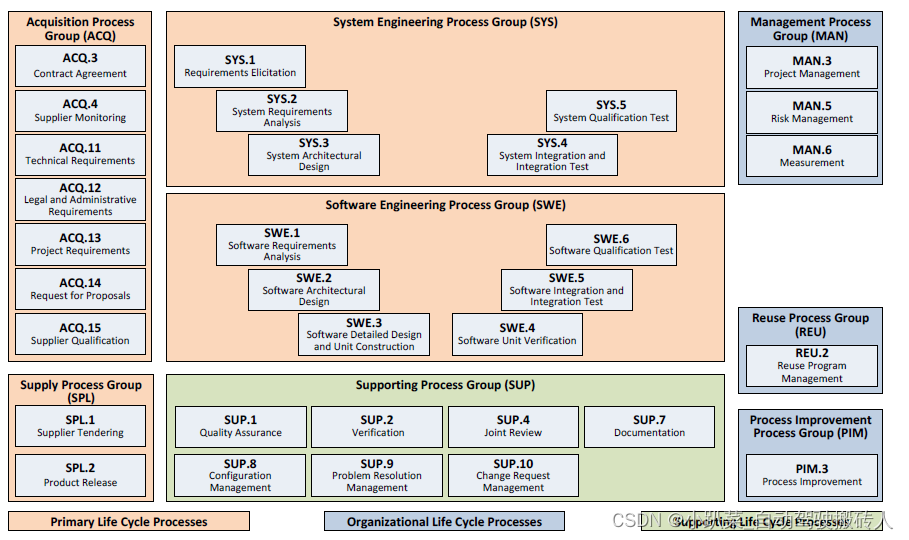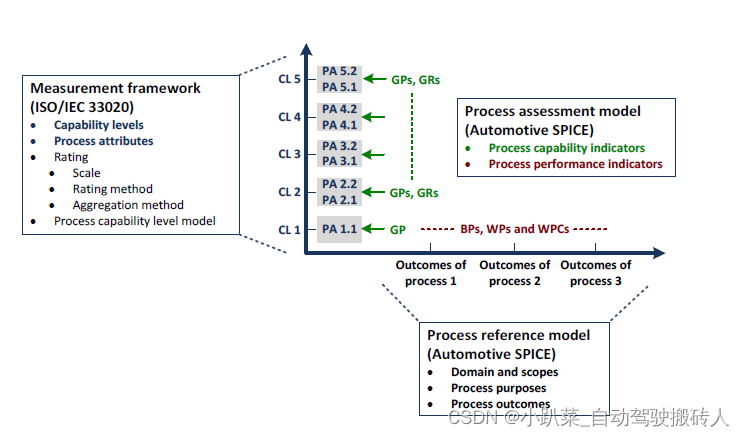文章目录
- 介绍
- 过程模型
- Primary life cycle processes category
- Acquisition Process Group
- Supply Process Group
- System Engineering Processes Group
- Software Engineering Processes Group
- Supporting life cycle processes category
- Organizational life cycle processes category
- Management Process Group
- Process Improvement Process Group
- Reuse Process Group
- 衡量基准
- 过程能力水平和过程属性
- 过程属性评级
- 过程能力水平模型
- 过程评估模型
- Process performance indicators
- Process capability indicators
介绍
ASPICE 全称是“Automotive Software Process Improvement and Capacity Determination”,汽车软件过程改进及能力评定,是汽车行业用于评价软件开发团队的研发能力水平的模型框架。最初由欧洲20多家主要汽车制造商共同制定,于2005年发布,目的是为了指导汽车零部件研发厂商的软件开发流程,从而改善车载软件的质量。多年以来,ASPICE在欧洲汽车行业内被广泛用于研发流程改善及供应商的研发能力评价。随着近年车联网、智能驾驶、新能源汽车的迅速发展,软件在汽车研发中的占比激增,企业对软件质量管理的需求不断增强,ASPICE逐渐被引入到国内,被国内的企业所熟知。另一方面随着TS16949的改版,对企业提出定期审核的要求,也对ASPICE在国内的应用起到的极大的促进作用。
过程模型
过程分为三大类:基础生命周期过程(Primary Life Cycle Processes)、组织生命周期(Organizational Life Cycle Processes)过程和支持生命周期过程(Supporting Life Cycle Processes)。每个过程都用目的声明来描述。目的声明包含流程在特定环境中执行时的唯一功能目标。对于每个目的陈述,都有一个特定结果的列表,作为过程性能的预期积极结果的列表。

Primary life cycle processes category
基础生命周期应由下方的活动共同组成:
1. 商务活动管理(Acquisition Process Group)
2. 供应商管理(Supply Process Group)
3. 系统设计活动(System Engineering Process Group)
4. 软件设计活动(Software Engineering Process Group)
Acquisition Process Group
Acquisition Process Group 由由顾客或下游供应商作为其供方的顾客执行的过程组成,以获取产品或服务。
1. ACQ.3 —— Contract Agreement
2. ACQ.4 —— Supplier Monitoring
3. ACQ.11 —— Technical Requirements
4. ACQ.12 —— Legal and Administrative Requirements
5. ACQ.13 —— Project Requirements
6. ACQ.14 —— Request for Proposals
7. ACQ.15 —— Supplier Qualification
Supply Process Group
Supply Process Group由供应商为提供产品或服务而执行的过程组成。
1. SPL.1 —— Supplier Tendering
2. SPL.2 —— Product Release
System Engineering Processes Group
System Engineering Processes Group由处理客户和内部需求的引出和管理、系统架构的定义以及系统层次上的集成和测试的过程组成。
1. SYS.1 —— Requirements Elicitation
2. SYS.2 —— System Requirements Analysis
3. SYS.3 —— System Architectural Design
4. SYS.4 —— System Integration and Integration Test
5. SYS.5 —— System Qualification Test
Software Engineering Processes Group
Software Engineering Processes Group由处理来自系统需求的软件需求管理、相应软件架构和设计的开发以及软件的实施、集成和测试的过程组成。
1. SWE.1 —— Software Requirements Analysis
2. SWE.2 —— Software Architectural Design
3. SWE.3 —— Software Detailed Design and Unit Construction
4. SWE.4 —— Software Unit Verification
5. SWE.5 —— Software Integration and Integration Test
6. SWE.6 —— Software Qualification Test
Supporting life cycle processes category
Supporting life cycle processes category包括在生命周期的各个点上可被任何其他过程使用的过程。
1. SUP.1 —— Quality Assurance
2. SUP.2 —— Verification
3. SUP.4 —— Joint Review
4. SUP.7 —— Documentation
5. SUP.8 —— Configuration Management
6. SUP.9 —— Problem Resolution Management
7. SUP.10 —— Change Request Management
Organizational life cycle processes category
Organizational life cycle processes category包括开发过程、产品和资源资产的过程,当这些过程被组织中的项目使用时,将帮助组织实现其业务目标。组织生命周期过程类别包括以下几组:
1. 管理过程组(Management Process Group)
2. 过程改进组(Process Improvement Process Group)
3. 复用过程组(Reuse Process Group)
Management Process Group
Management Process Group(MAN)由管理生命周期内任何类型的项目或过程的任何人都可以使用的过程组成。
1. MAN.3 —— Project Management
2. MAN.5 —— Risk Management
3. MAN.6 —— Measurement
Process Improvement Process Group
Process Improvement Process Group(PIM)涵盖一个包含改进组织单元中执行的过程的实践。
1. PIM.3 —— Process Improvement
Reuse Process Group
Reuse Process Group(REU)涵盖了一个用于系统地利用组织的重用计划中的重用机会。
1. REU.2 —— Reuse Program Management
衡量基准
衡量基准为能力维度提供必要的需求和规则。它定义了一个模式,使评估人员能够确定给定流程的能力级别。这些能力级别被定义为衡量基准的一部分。为了启用评级,衡量基准提供了定义过程能力的可度量属性的过程属性。每个过程属性被分配到一个特定的能力级别。某一过程属性的实现程度通过基于已定义的等级量表的等级来表示。评估人员可以从中得出给定过程的最终能力级别的规则由过程能力级别模型表示。ASPICE 3.1使用ISO/IEC 33020:2015中定义的衡量基准。
过程能力水平和过程属性
过程能力水平和过程属性与ISO/IEC 33020条款5.2中定义的相同。能力级别和相应过程属性的详细描述可以在第5章中找到。过程属性是过程的特征,可以根据成就的尺度进行评估,提供对过程能力的度量。它们适用于所有过程。能力水平是一组过程属性,它们一起工作以提供执行过程的能力的主要增强。每个属性处理能力水平的一个特定方面。这些层次构成了一种通过改进任何过程的能力而取得进展的合理方式。根据ISO/IEC 33020,有六个能力级别,包含九个过程属性:
| Process capability levels according to ISO/IEC 33020 | ||
|---|---|---|
| Level 0 | Incomplete process | The process is not implemented, or fails to achieve its process purpose. |
| Level 1 | Performed process | The implemented process achieves its process purpose |
| Level 2 | Managed process | The previously described performed process is now implemented in a managed fashion (planned, monitored and adjusted) and its work products are appropriately established, controlled and maintained. |
| Level 3 | Established process | The previously described managed process is now implemented using a defined process that is capable of achieving its process outcomes. |
| Level 4 | Predictable process | The previously described established process now operates predictively within defined limits to achieve its process outcomes. Quantitative management needs are identified, measurement data are collected and analyzed to identify assignable causes of variation. Corrective action is taken to address assignable causes of variation. |
| Level 5 | Innovating process | The previously described predictable process is now continually improved to respond to organizational change. |
| Process attributes according to ISO/IEC 33020 | |
|---|---|
| Level 0: Incomplete process | |
| Level 1: Performed process | |
| PA 1.1 | Process performance process attribute |
| Level 2: Managed process | |
| PA 2.1 | Performance management process attribute |
| PA 2.2 | Work product management process attribute |
| Level 3: Established process | |
| PA 3.1 | Process definition process attribute |
| PA 3.2 | Process deployment process attribute |
| Level 4: Predictable process | |
| PA 4.1 | Quantitative analysis process attribute |
| PA 4.2 | Quantitative control process attribute |
| Level 5: Innovating process | |
| PA 5.1 | Process innovation process attribute |
| PA 5.2 | Process innovation implementation process attribute |
过程属性评级
为了支持过程属性的评级,ISO/IEC 33020测量框架提供了一个定义的评级量表,根据评估的类别(例如组织成熟度评估所需的),提供了一个细化选项、不同的评级方法和不同的汇总方法。
| Rating scale according to ISO/IEC 33020 | |||
|---|---|---|---|
| N | Not Achieved | There is little or no evidence of achievement of the defined process attribute in the assessed process. | 0 to ≤ 15% achievement |
| P | Partially achieved | There is some evidence of an approach to, and some achievement of, the defined process attribute in the assessed process. Some aspects of achievement of the process attribute may be unpredictable. | > 15% to ≤ 50% achievement |
| L | Largely achieved | There is evidence of a systematic approach to, and significant achievement of, the defined process attribute in the assessed process. Some weaknesses related to this process attribute may exist in the assessed process. | > 50% to ≤ 85% achievement |
| F | Fully achieved | There is evidence of a complete and systematic approach to, and full achievement of, the defined process attribute in the assessed process. No significant weaknesses related to this process attribute exist in the assessed process. | > 85% to ≤ 100% achievement |
| Refinement of rating scale according to ISO/IEC 33020 | |||
|---|---|---|---|
| P- | Partially achieved | There is some evidence of an approach to, and some achievement of, the defined process attribute in the assessed process. Many aspects of achievement of the process attribute may be unpredictable. | > 15% to ≤ 32.5% achievement |
| P+ | Partially achieved | There is some evidence of an approach to, and some achievement of, the defined process attribute in the assessed process. Some aspects of achievement of the process attribute may be unpredictable. | > 32.5% to ≤ 50% achievement |
| L- | Largely achieved | There is evidence of a systematic approach to, and significant achievement of, the defined process attribute in the assessed process. Many weaknesses related to this process attribute may exist in the assessed process. | > 50% to ≤ 67.5% achievement |
| L+ | Largely achieved | There is evidence of a systematic approach to, and significant achievement of, the defined process attribute in the assessed process. Some weaknesses related to this process attribute may exist in the assessed process. | > 67.5% to ≤ 85% achievement |
过程能力水平模型
根据下表中定义的过程能力级别模型,过程所达到的过程能力级别应从该过程的过程属性评级中得出。过程能力级别模型定义了每个级别的实现如何依赖于被评估的和所有较低级别的过程属性的评级的规则。作为一般规则,要达到给定的级别,需要在很大程度上实现相应的过程属性,并完全实现任何较低的过程属性。
| Process capability level model according to ISO/IEC 33020 | ||
|---|---|---|
| 级别 | 过程属性 | 等级 |
| Level 1 | PA 1.1: Process Performance | Largely |
| Level 2 | PA 1.1: Process Performance | Fully |
| PA 2.1: Performance Management | Largely | |
| PA 2.2: Work Product Management | Largely | |
| Level 3 | PA 1.1: Process Performance | Fully |
| PA 2.1: Performance Management | Fully | |
| PA 2.2: Work Product Management | Fully | |
| PA 3.1: Process Definition | Largely | |
| PA 3.2: Process Deployment | Largely | |
| Level 4 | PA 1.1: Process Performance | Fully |
| PA 2.1: Performance Management | Fully | |
| PA 2.2: Work Product Management | Fully | |
| PA 3.1: Process Definition | Fully | |
| PA 3.2: Process Deployment | Fully | |
| PA 4.1: Quantitative Analysis | Largely | |
| PA 4.2: Quantitative Control | Largely | |
| Level 5 | PA 1.1: Process Performance | Fully |
| PA 2.1: Performance Management | Fully | |
| PA 2.2: Work Product Management | Fully | |
| PA 3.1: Process Definition | Fully | |
| PA 3.2: Process Deployment | Fully | |
| PA 4.1: Quantitative Analysis | Fully | |
| PA 4.2: Quantitative Control | Fully | |
| PA 5.1: Process Innovation | Largely | |
| PA 5.2: Process Innovation Implementation | Largely | |
过程评估模型
过程评估模型提供了一些指标,以确定在项目和组织单元的实例化过程中是否存在过程结果和过程属性结果。这些指标为评估人员积累必要的客观证据以支持能力判断提供指导。它们不应被视为必须遵循的检查清单。为了判断过程结果和过程成果是否存在,评价需要获得客观证据。所有这些证据都来自于对被评估过程的工作产品和存储库内容的检查,以及被评估过程的执行者和管理者提供的证据。该证据被映射到PAM指标,以建立与相关过程结果和过程属性成就的对应关系。有如下两类指标:
1. Process performance indicators
2. Process capability indicators
评估指标用于确认某些实践得到了执行,如评估期间收集的证据所示。所有这些证据要么来自对所评估过程的工作产品的检查,要么来自过程的执行者和管理者的陈述。基本实践和工作产品的存在为与之相关的过程的性能提供了证据。同样,过程能力指标的存在提供了过程能力的证据。所获得的证据应以与相关指标明确相关的形式记录下来,以便按照ISO/IEC 33002的要求确认或验证审核员判断的支持。
Process performance indicators
过程性能指标的类型有如下:
1. Base practices (BP)
2. Work products (WP)
BP和WP都与一个或多个过程结果相关。因此,BP和WP总是特定于过程而不是通用的。BP代表面向活动的指标。WP是面向结果的指标。BP和WP都用于判断评估员在评估过程中要收集和积累的客观证据。在这方面,BP和WP是评估员可以使用的替代指标集。PAM为每个WP提供了一组工作产品特征。这些为评估员提供良好的实践和最先进的知识指南。因此,在评估过程中,WP和WPC应该是一个快速访问的信息源。在这方面,WP和WPC只是一个示例结构。它们既不是“严格要求”,也不是组织的规范。相反,实际的结构、形式和实现过程的具体工作产品和文档的内容必须分别由项目和组织定义。项目和组织确保工作产品适合预期的目的和需求,并且与开发目标相关。
Process capability indicators
过程能力指标的类型有如下:
1. Generic Practice (GP)
2. Generic Resource (GR)
GP和GR都与一个或多个PA成就相关。然而,与过程绩效指标相比,它们是通用型的,也就是说,它们适用于任何过程。GP与GR的区别在于前者代表活动导向的指标,后者代表判断客观证据的基础设施导向的指标。评估人员必须在评估期间收集和积累支持过程能力指标的证据。尽管过程的第1级能力仅以过程结果实现程度的度量为特征,但衡量基准要求每个级别显示一个过程属性,因此,要求PAM引入至少一个过程能力指示器。因此,能力级别1 (PA.1.1)的唯一过程性能属性具有单个通用实践,作为对各自过程性能指示器的编辑引用。


AI算法大模型备案线上活动)
)


)





)
![ros找不到生成的可执行文件[rosrun] Couldn‘t find executable named hello_world_cpp below](http://pic.xiahunao.cn/ros找不到生成的可执行文件[rosrun] Couldn‘t find executable named hello_world_cpp below)

![【P4924】[1007] 魔法少女小Scarlet](http://pic.xiahunao.cn/【P4924】[1007] 魔法少女小Scarlet)




